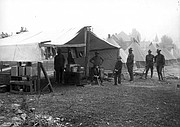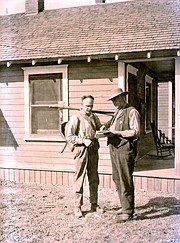“Tinder Dry, Ready to Explode:” The Prelude to the Big Burn
On Aug. 20, 1910, hot and dry, high winds whipped the many small fires burning throughout the region into an inferno that would burn three million acres in just a few short days. While the worst of the fires culminated in late August, it had not been an easy summer for the Forest Service crews tasked with fighting the many fires that broke out.
In June 1910, fires began to break out in the forests and mountains surrounding the Silver Valley. The spring rain in April had been almost nonexistent and the forests were extremely dry. July saw several lighting storms sweep through the area. These storms along with campers and sparks from the two railroads in the area started several fires. As more lightning storms passed through the area in the second half of July and more fires started, Forest Service firefighters were sent out as soon as possible to deal with them. With new fires starting almost every day and the wind helping spread the flames, the fire conditions surrounding the Valley were growing worse.
According to a history of the Big Burn written by Forest Service Supervisor, Elers Koch, the five or six years prior to 1910 had not seen many major fires in the region and had been fairly calm years. 1908 was the exception. The Chicago, Milwaukee and St. Paul Railway was just finishing construction in 1908 and did start several fires in the process of building the railroad. These fires allowed the Forest Service personnel to gain some experience handling large crews while fighting forest fires.
By July 15, 1910, there were around 3,000 men fighting the constantly occurring fires of the region. Men were brought in from Spokane, Missoula and Butte to join the fire crews. A crew of 50 men was considered large and in many cases five or 10 men were fighting fires that might need 100 men to really be effective. On Aug. 8, 1910, President Taft authorized the regular Army to help with the fire fighting efforts. They were sent in to help in the Coeur d’Alene, Lolo and Flathead Forests. By Aug. 15, 1910, more than 3,000 small fires and 90 large ones had been controlled.
With fires burning to the west in Pine Creek and to the south, residents of Wallace were beginning to worry. Newspapers reported that the insurance clerks in town were kept busy writing fire insurance policies.
Just days before the Great Fire of 1910 began residents seemed to be feeling cautiously optimistic that the Forest Service fire crews were making some progress in their efforts against the many fires burning throughout the region. On Aug. 11, 1910, The Wallace Miner wrote, “The serious shortage of water for the past months coupled with forest fires of unparalleled fury, has had a tendency to reduce prospecting and the development of prospects to a minimum. From the fire-swept area the news is of a more reassuring nature. The force fighting the spread of the flames is making some headway and unless high winds come they will be checked in a few days more. With the extraordinary dryness of the weather however there is constant danger from this source as new fires may start any minute, and until weather conditions change, vigilance may not be relaxed for an hour.”
On Aug. 18, 1910, just two days before the Big Burn started, The Wallace Miner reported, “Fire dangers are now being reduced through the activity of the Forestry department and the co-operation of mine and timber owners. Actual mining may be expected now to show greater activity than for the past few weeks.” Two days later on Aug. 20, 1910, the wind started to blow.





